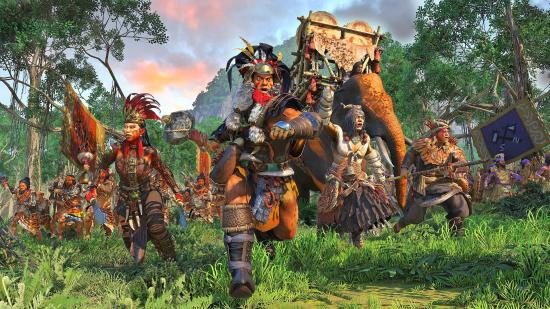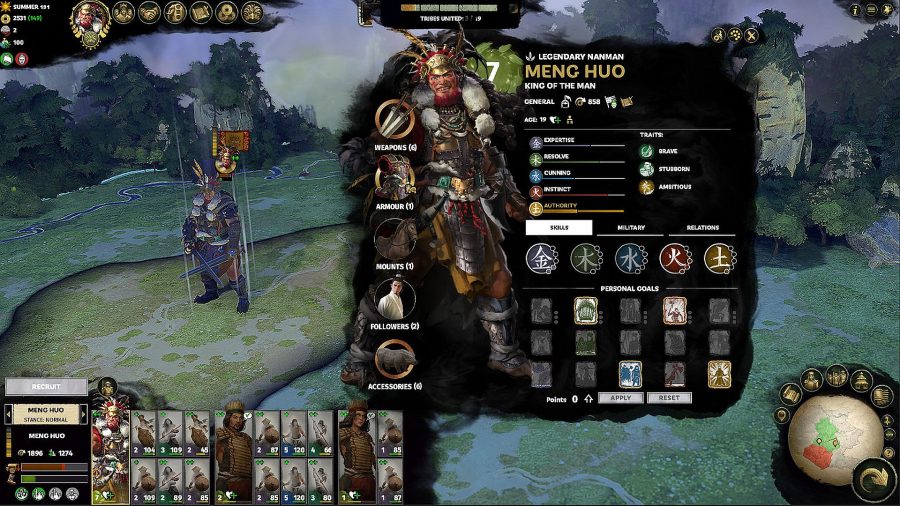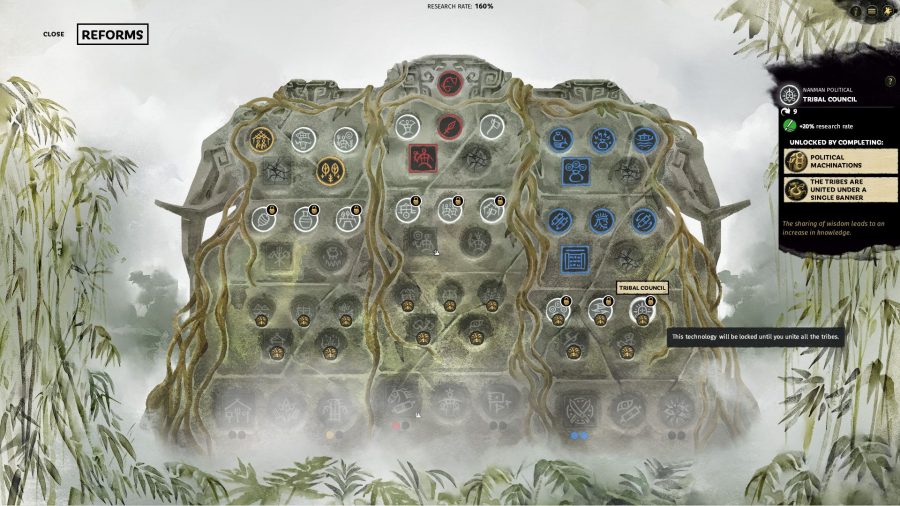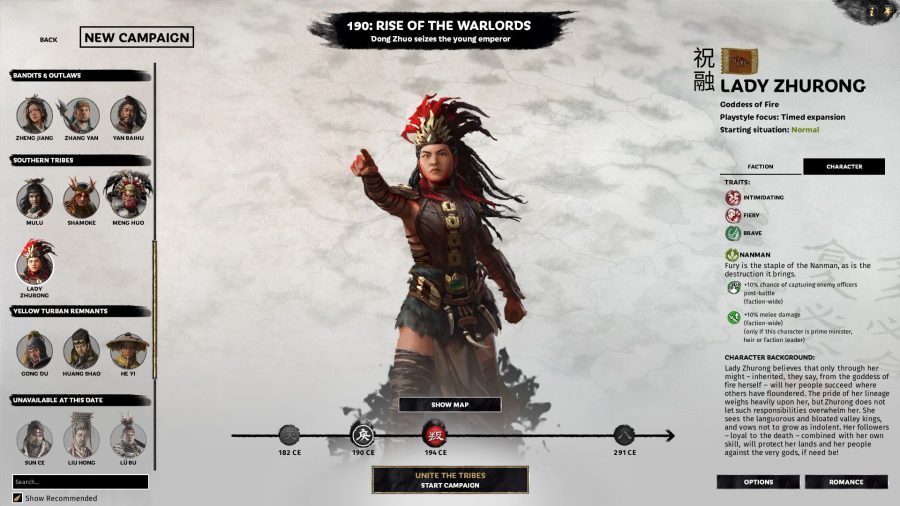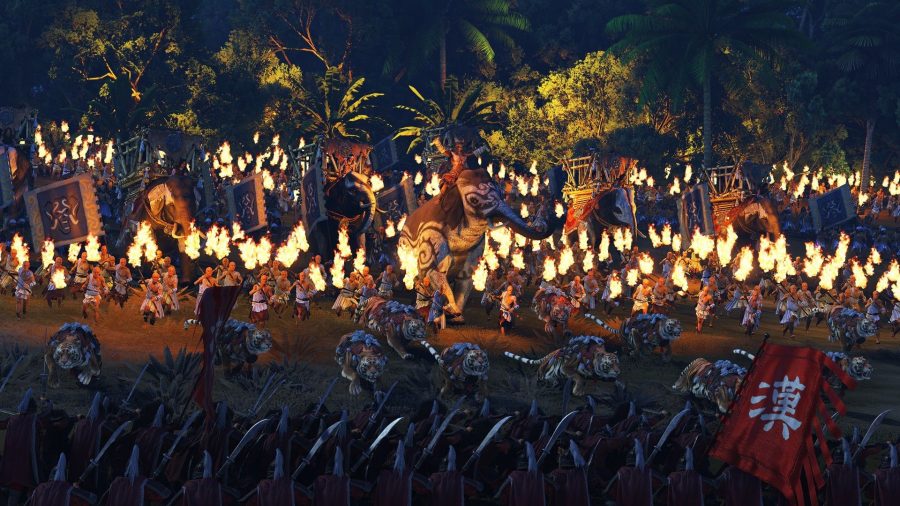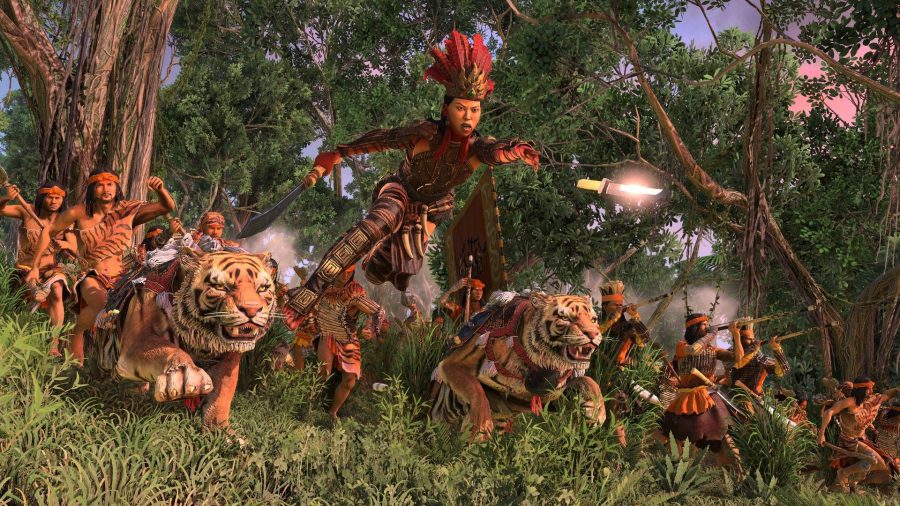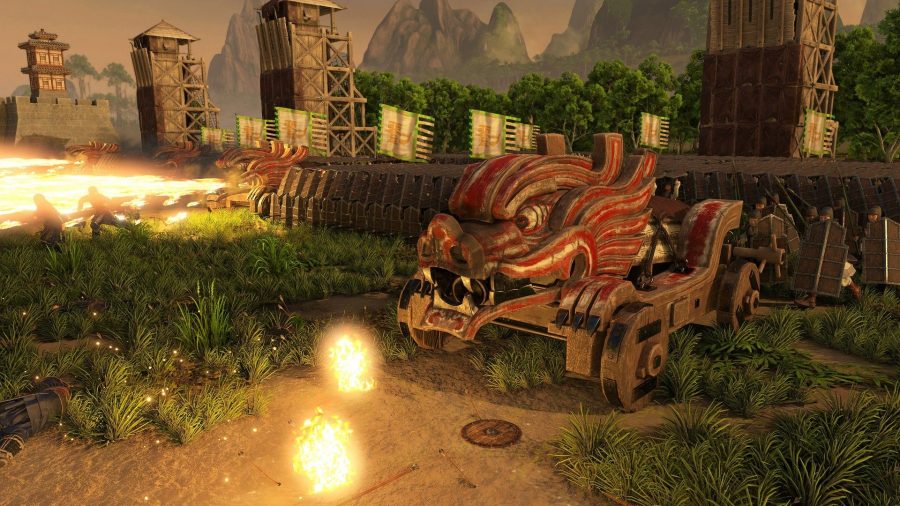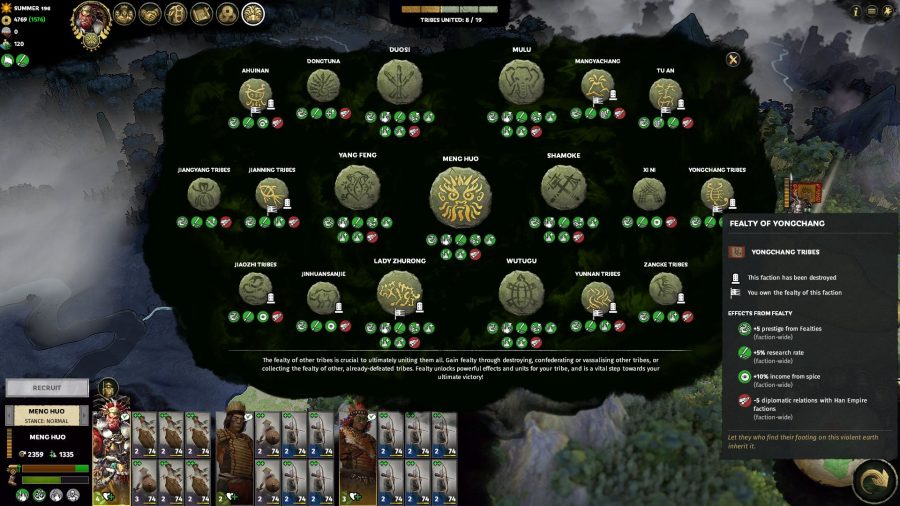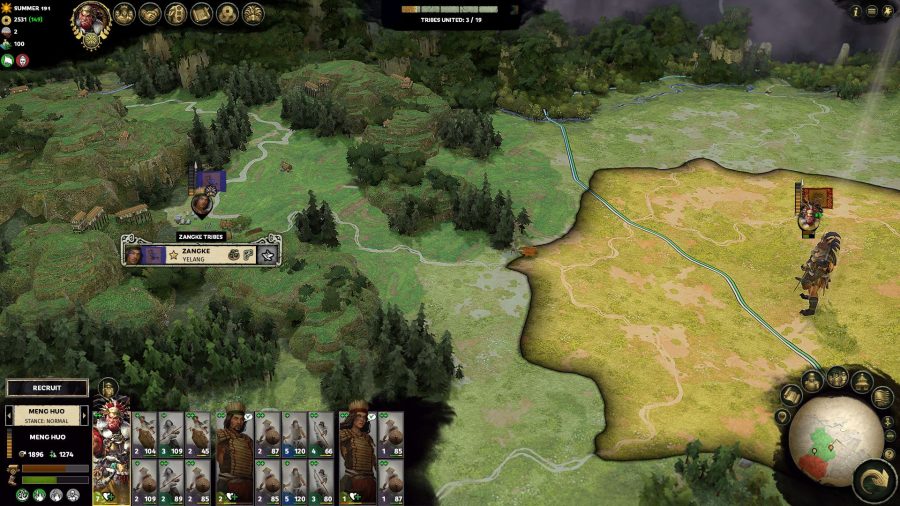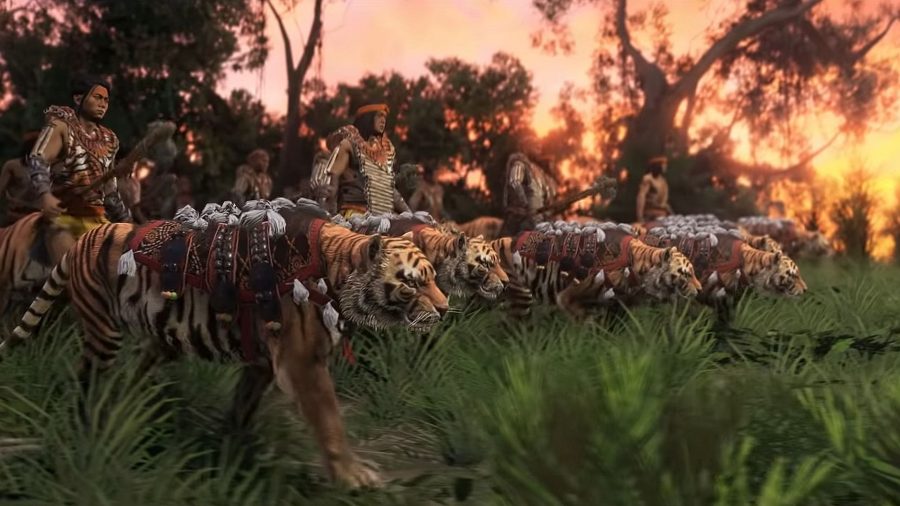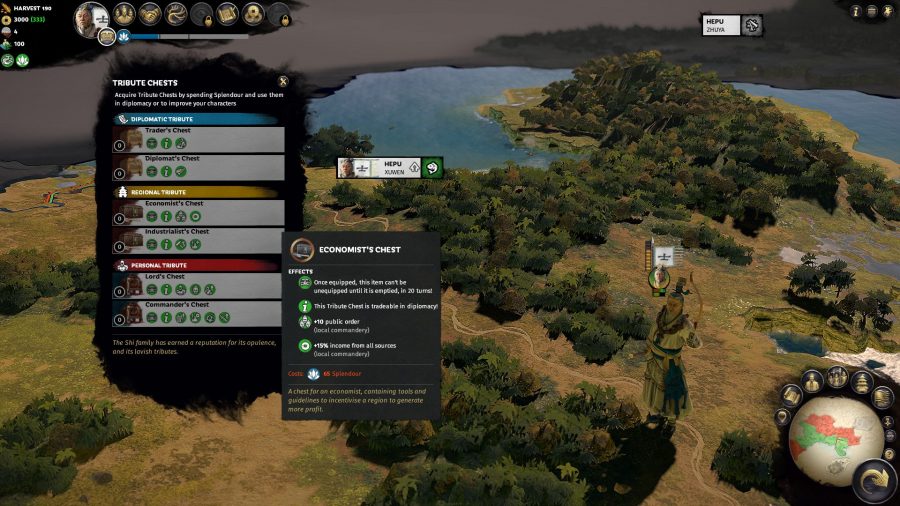Yesterday, the biggest piece of DLC yet for Total War: Three Kingdoms was announced. The Furious Wild will be the game’s first fully fledged ‘expansion pack’ – as opposed to the chapter packs released to date – and will add four new factions from a wholly new culture, the Nanman, when it releases on September 3.
In stark contrast to the regimented Han and their successors, the Nanman are a group of jungle-dwelling tribes. Players craving something of Total War: Warhammer’s unit diversity will be thrilled to hear that they’ll add over 25 new units, utilise entirely different weaponry and tactics, pursue all-new campaign goals, and that each of the four new leaders will play differently. The paid expansion will also land alongside a free update that will expand the campaign map to include the Nanman homelands in China’s southwestern jungle, as well as adding new Lord (Shi Xie), new units, and Gate Pass battle maps.
To dig into all this goodness for more detail on how the Nanman play, their basis in history, and how developer Creative Assembly is continuing to satiate the ravenous appetite of its broadest, most global audience yet, we spoke exclusively with senior designer Simon Mann.
PCGamesN: The Nanman have been much requested by the community. What’s your sense of what players are looking for from them, and do you think you’ve delivered?
Simon Mann: We’re always looking at what the players are talking about, it’s a big thing for us. We’ve noticed people discussing diversity, especially of unit rosters and characters, and we always felt that the Nanman would offer a lot of interesting opportunities when it comes to things like that – we’re talking rosters of animals, tamed beasts, this kind of jungle feeling that you get from the southern areas of China.
So our big goal when we set out on this project was to create a really interesting new kind of culture and roster, to give players almost a contrast to what they’ve been getting from the Han, and I think that perspective has been absolutely great. I really, really think the new Nanman roster is something totally different – I don’t think even players who’ve been expecting the Nanman will expect what we’ve done. We’ve taken it to some really interesting places, and that’s also enabled us to do an interesting new campaign – the Nanman’s ideals and goals are completely separate to those of the Han, so you’re getting a whole new-feeling experience but in the same universe.

Because of their asymmetric campaign goals, you’re almost playing two campaigns. At first, you’re a Nanman aspirant – you want to become the king and unite the tribes. So there’s this amazing phase where you’ll have many wars against the other small factions; you’re forming alliances, you’re vassalising them, you’re confederating them into your own banner.
But then when the dust settles on that first phase, you’ve got a second, when suddenly you have to deal with the rest of China. All this time you’ve been looking inwards at the Nanman’s lands and not really paying attention to the rest of the country, but now suddenly you shift into this second game state, where you have to interact with the Han in order to continue the game. I found that a really fresh thing within our campaign.
I presume it’s safe to assume that you won’t declare yourself Emperor in the same way that the endgame shakes out for everyone else? What’s the end state of that second phase of the game, your ultimate goal as the Nanman?
This is something else we played around with. So for all the Nanman factions, their core goal is first to unite the tribes and become the king – King Meng Huo, as he would have been. But you’ve then got to actually found your kingdom, and to do that you’ve got to be recognised by the Han. So you have to start expanding into their lands, take some for yourself, and then hold that land for an extra time, which is your victory condition.
But one of the factions is King Shamoke – he fought for Liu Bei quite a lot during the later periods of the Three Kingdoms, and was known to be split between the Han and his own people. He’s the only Nanman that actually can become the Emperor – he’s able to essentially change his victory condition, which is a choice you’ll get to make as you play through his campaign.
There are many choices within the Nanman campaign mechanics – lots of moments where you’re asked to go down one path or another, that will affect how your game plays out. The reforms tree for the Nanman, for instance, presents you with decisions that will lock out other parts of the tree, so at certain junctures you’re asked to choose between one reform which leans more towards the Nanman’s traditional, tribal jungle culture, and the other represents you reforming your tribe, trying to become something more sinicised and ‘Han-like’, and that will actually open and close various doors for you in the campaign.
Based on your decisions, you may find yourself acting as a mercenary for various factions, or, like Shamoke, becoming essentially a Han faction, and having all of the same tools a Han faction would. Plus elephants.
Newcomer? Check out our guide to the best Total War games
I think this would be the first time in Total War that we’ve seen a faction change culture – tech, units, et cetera – halfway through a campaign.
When we were thinking about what this game was going to be – because we’re set quite a long way before their appearance within the novels – we really wanted to play through the story of it, like: how did they get to that point? How did Meng Huo come to lead them? And he has all these other tribes at his beck and call, and in his seven defeats he’s literally going to every other tribe and going ‘give me some soldiers, give me some help!’ But of course, because we’re a sandbox, it’s not always going to be Meng Huo – it could be King Mulu, right? It could be Lady Zhurong. So it’s this kind of prelude if you will, a prologue, to the events of the book.
Can you give us an overview of the other new factions at the strategic level?
Having a ‘base’ faction was one of the concepts we defined, and that’s Meng Huo. He’s not got that much in the way of weird mechanics to him, he’s a pure Nanman faction – certainly when you’re reading The Romance [of the Three Kingdoms] novel, he’s held up as the exemplar of what it is to be Nanman. The others have certain ‘mutators’ that make them very different to that benchmark. King Shamoke, as I say, is able to become the Emperor and completely change his faction’s destiny throughout the campaign.
Lady Zhurong is descended from the God of Fire, and we really built her mechanics around that – she’s able to inspire her people to greater feats by triggering these rites that allow soldiers to fight better or her economy to run stronger. You’ll get different effects from this based on the season you’re in, but you don’t want to save it for too long, because you’ll actually start getting penalties for not using the mechanic.
And finally King Mulu is a kind of shaman, so he’s got these rites and areas of the map that he’s got to capture. He’s doing a little whistle stop tour of southern China, as it were, where he’s trying to build up these rites that allow him these new powerful effects that he’s able to apply to his entire faction.
I understand that the Nanman’s depiction in the Romance is somewhat fictionalised – even more so than everyone else. What kinds of historical sources did you have for them?
In this instance, the Romance, and the heroic events that occur around the Nanman in the southern campaign, were definitely our main inspiration. But from that point we started to look at the historicity of the Nanman themselves. We’re fairly sure that the characters [in the Romance] are likely [or substantially] fictional – there are mentions, but nothing you’d call concrete.
Read more: Check out the best strategy games on PC
But the peoples themselves and their culture, the geography of the region, their dress, things like that – that’s all stuff we’re able to research. So though the characters may be fictionalised to a degree, we’ve pulled in a lot of historical facts to build our narrative. In some regards, setting it before the period of the Romance novel gave us more freedom to explore the historical side – we had to come up with Nanman names, because obviously Nanman characters will spawn throughout the game who aren’t strictly historical. So we worked very closely with Chinese academics to build a naming group for them, and again there was a lot of historical research needed to make that work.
I bet that process was fascinating.
It was! It took a while – getting the names together, certainly, was quite a challenge. You have names that look or sound similar to Han, but actually the Chinese character is completely different. So yeah, there was a lot of trial and error as we kind of found our way towards that.
As long as we’re talking about historical accuracy, is there any historical precedent for tamed tigers being used in war?
There’s certainly talk of tamed animals, especially in the Romance novel, and you can definitely find historical examples of animals used in battle across the world. I don’t think I’ve got a specific citation for it, but I think it’s definitely something that’s feasible.
I know there’s lots of evidence of elephants, dogs, and so on, but one imagines that tigers are too difficult to tame. Maybe it’s about opening a cage and poke them at the enemy.
That’s kind of how they work, really. We’ve got two tiger units available – they both belong to Lady Zhurong – and your unit starts with the tigers, then you actually release those tigers onto the enemy, so they’re not running side by side [with you], as it were. This gives you some really interesting tactical gameplay, because you can attack [one target] with the tigers and then use the rest of the unit to attack someone else.
I want to also ask about one of the new free units, the juggernaut. What’s the background to that?
That was also inspired by the southern campaign. Even though we weren’t strictly touching on the southern campaign, we really wanted to add this in because we got extremely excited when we found out about it. Supposedly Zhuge Liang used them against the Nanman. Essentially they were a form of flamethrower – we were watching a lot of the TV series of the Three Kingdoms and getting quite excited when we saw that used in battle.
So we decided we’re going to do this unit, but once again use it as an opportunity to do something interesting in battle – it’s an extremely lumbering unit, it’s very slow to move, slow to fire, and slow to fire again. It’s essentially a siege engine, although it’s not used for besieging. It’s one of those units that if you get hit by it, you die, but you can use its lack of speed against it tactically.
That’s interesting for the Nanman because of course, they don’t have cavalry. Their battle tactics are based on a strong front line of infantry, and they rely on these animal units to close the gap, cause confusion in the enemy ranks and break their line. Then they use some of their lighter units which are actually able to flank around, and take down enemy siege weaponry, archers, things like that.
Get excited: Check out the most promising upcoming PC games
It’s such a contrast with the Han’s units and tactics. Does it not stretch credulity that these tribes could compete against more organised, technologically advanced empires? How have you dealt with that?
Actually one of the things we really wanted to push with the Nanman is that no, they can’t compete against the trained, drilled army of the Han – it would pretty much decimate them and pull them apart. So we push you to unite the tribes, and as you do so, you get stronger – your armies essentially power up until you’re at the point where you can compete.
It’s something we want you to be aware of. As King Mulu, for example, you start right next to Shi Xie, and you’re a little bit scared of him, right? Because even though he’s got his own problems, you know that if he turns his attention to you too early, you’re going to be in real trouble. Fighting a defensive war as the Nanman really isn’t a good idea. They’re not built for it. Their cities don’t even have stone ramparts or walls – we’ve added new Nanman settlements for the DLC, and they’re open, way easier to attack.
The Nanman are all about offense, but when you have an enemy you can’t defeat, that’s when you look inwards to unite the tribes, and thereby gain the strength to push outwards. That’s done through a system we’ve called the fealty system. Whenever you conquer, ally with, or vassalise another Nanman tribe, you gain their fealty, and that represents the culture and traditions of that particular group, because you must remember the Nanman aren’t one nation – there are various groups of people in that southwestern area of China – and gaining their fealty is what gives you the strength to fight the Han, as well as giving you access to the faction-specific units, so your roster is also building as you go through the campaign.
I want to ask about the expansion to the map – you mentioned the Nanman will have 21 regions in the southwestern jungle. How does that compare to the base game, just to give a sense of proportion?
Those 21 regions include ones that already exist – I think we’ve added four brand new provinces, which allows us to extend the map out to the southwest, and then we’ve added an extra province in the far northeast as well, because as part of this update we’ve also done a full revamp of the entire campaign map. We’ve had quite a lot of feedback, especially from Chinese players, that some region names weren’t quite correct or some of the borders were wrong.
I gather there’s a mountain that’s in the wrong place too.
Yes, that’s still in the wrong place at the moment! But again, we’re looking to the future, and we’ll probably continue this process now we’ve started it – we feel comfortable to continue making updates to the map. Some provinces have gone, some have moved, some have got larger, some have gained new regions. We’ve also added gate battles, so some of the famous gate passes that you’ll have heard about, like Hulao, Tong, they’ve all been added to the game and are now present on the campaign map, even without the Furious Wild DLC.
Yes, this is all part of the free patch. It compares with Warhammer II’s DLC cadence, in which you get a paid Lord pack plus a free patch with some free units and a free Lord. Can we expect Three Kingdoms to mirror that cadence going forward?
I’m not sure I can say too much; I don’t get involved in the planning. But I would hope so. Our main goal is that we always want to continue supporting our game, and again, we look at what the community is asking for and consider how we can fit that in to make the game better for everyone.
I want to raise a dev blog in which you acknowledged that players were “looking for something else” from the Eight Princes DLC – what did you mean by that, and can you sum up what you’ve learned from your DLC so far?
I’m not too aware of the changes to Eight Princes, I’m afraid. With regard to the DLC experience in general, though – we’ve done a few now, and I do know that we’ve got a couple more in the pipeline that I think will have at least an equal interest to the ones we’ve done.
We’ve learned that we’ve got a very diverse player base, and that all those players want slightly different things. I think we’re better at trying to please as many people as we can with each DLC, because we really want everyone to play it and love it.
We’ve got a lot of different player types across the world – we’ve got global appeal with this particular game, and I think we’ve learned how to build those relationships amd make the game that all those people are expecting. We’re doing a lot more with discussion with the Chinese community, because they know this stuff like the back of their hand. I believe the Romance was on the school curriculum there for a little time, and I think many would have studied the Records as well. It’s a group who are interested not just in the game, but also in the history surrounding it.
Can you give some examples of what each community asks for? What’s more important to your Chinese audience versus your traditional Western audience?
The biggest one with the Chinese community is getting China right! That’s why we’ve done this very large map change, which adds a lot of historicity – I think the map was already quite good, but [that demand] has enabled us to take it even further than we originally did.
One of the reasons the Furious Wild DLC had such allure to us as developers was because we hear quite often that unit variety is something people feel is slightly lacking, especially in the West – you know, can we have more interesting things to utilise in battle?
We have a lot of units and they enable a lot of play, but because we’re a monoculture, I think to a certain extent we’re slightly locked into what [limited] unit variety we have available. So this is one of those things where the Nanman were a really good answer to that question, and some of their units will even be available to the other factions. The bandit factions are able to access some of the Nanman units if they expand the bandit network to the southwest, for instance.
So those are some examples of the differing needs of the audiences, but you can’t strictly break it down to east and west. We’ve had varying feedback from all over the world, but that’s been a really good thing, as we’ve been able to look at what all those players want the most and respond.
Total War: Three Kingdoms – The Furious Wild is due for release on September 3. You can learn more, or pre-order with a 10% discount on its price of $18.99/£14.99 until release day, on the Steam page.
